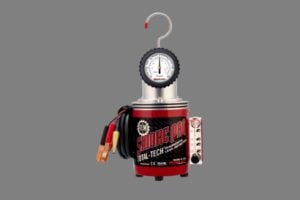How to test for Boost leaks?
As the name suggests here at GotBoost Racing we are experts at diagnosing ‘Forced Induction’ faults. The most common of which is a boost leak.
How to test for Boost leaks?

Boost Leak Diagnosis
If you drive a turbocharged vehicle boost leaks are a fact of life, most turbocharged vehicles will suffer from boost leaks during their lifetime. We pioneered the use of leak detection tools such as the smoke pro. We also use our own high-pressure system for identifying leaks under the higher pressures modified vehicles subject the intake system to.
What is a Boost Leak?
It is simply an air leak. It happens when the intake of your engine is no longer gas-tight. Unlike a normally aspirated (NA) engine a forced induction (turbocharged or supercharged) engine is fed pressurised air to improve its volumetric efficiency (VE). This improves the performance of the engine.
Symptoms of a Boost leak
- Boost leaks can result in poor performance, your car doesn’t feel as fast as it once did.
- Warning lights on the dash, the sophisticated engine management systems fitted to modern vehicles monitor the various systems and report errors in the form of Diagnostic Trouble Codes (DTCs) which may or may not illuminate the Malfunction Indicator lamp (MIL) on the dashboard.
- Visible smoke from the exhaust, and the boost leak may result in the incorrect fuel/air mixture entering the engine resulting in black smoke. Especially on diesel engines where exhaust after-treatment systems such as Diesel Particulate Filters (DPF) may become blocked as a result.
- Poor idle characteristics, higher emissions and fuel consumption can all be attributed to air leaks.
Why you MUST fix boost leaks
Boost leaks can result in the failure of your turbocharger. Even small leaks place additional stress on the turbo as it is made to work harder to maintain the desired pressure in the manifold. This could lead to premature turbo failure. Large leaks result in overspeeding of a device that is already spinning at over 200-300,000 rpm. This can result in the turbo bearings failing and even the shaft snapping in extreme circumstances.
How to test for Boost Leaks
Visual Inspection
- Visually Inspect All Couplers and Clamps, this is the most common source of boost leaks and can happen after installing bolt-ons or other modifications that require the removal of the charge piping.
- Starting at the compressor housing, work your way towards the intercooler and up towards the throttle body. Check for visible signs of oil around all pipes and couplers. The presence of oil is an indication of a leak or past leak.
- Check all joints and couplers are good and tight. A good method of insurance is to replace all ring-worm clamps with t-bolt clamps for ultimate clamping power and to reduce the risk of the clamp chaffing a hole in the coupler.
If all of these are in good condition, head to the next step
Using a Leak Detector
- A boost Leak Detector is a great tool for testing if you think you have a boost leak. It uses smoke and compressed air to identify the source of the leak.
- A boost leak Detector allows you to pressurise the system without having to start the car or bring it up to load. You simply remove the turbo inlet, attach the boost leak tester, hook the tester up to an air compressor, and allow the system to pressurise. From there, you can listen for leaks, observe the smoke, and check the gauges to establish the size of the leak.
Our Location
Find Us
31 Sturmi Way
Village Farm Industrial Estate
Pyle, Bridgend
Mid Glamorgan
CF33 6BZ
01656 670741
Opening Times
| Monday | 09:00 - 17:30 |
|---|---|
| Tuesday | 09:00 - 17:30 |
| Wednesday | 09:00 - 17:30 |
| Thursday | 09:00 - 17:30 |
| Friday | 09:00 - 17:30 |
| Saturday | Closed |
| Sunday | Closed |



Car Repairs & Services
- Airbag Repairs
- Auto Electrics
- Brake Disc Skimming
- Cambelts
- Campervan Repairs & Servicing
- Car Air Conditioning
- Car Batteries
- Car Brakes
- Car Exhausts
- Car Modifications
- Car Repairs
- Car Servicing
- Car Tyres
- Clutch Replacement
- Diesel Particulate Filter Cleaning
- Diesel Performance ECU Tuning
- Dyno Services
- ECU Remapping
- Electric Car Repairs & Servicing
- Engine Diagnostics
- Engine Rebuilds
- Engine Remapping
- Engine Tuning
- Hybrid Car Repairs & Servicing
- Milltek Car Exhausts
- Steering
- Suspension
- Wheel Alignment
- All Car Repairs & Services…
© GotBoost Racing - 2024






